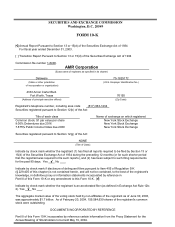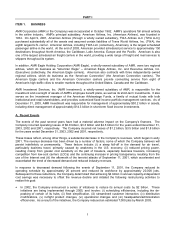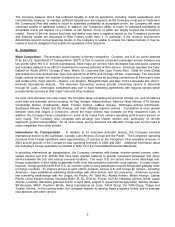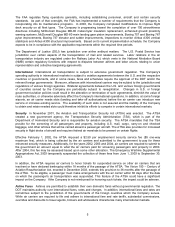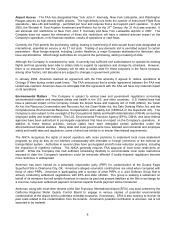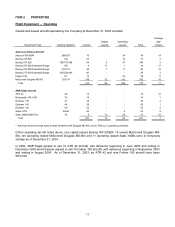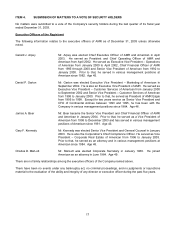American Airlines 2003 Annual Report Download - page 12
Download and view the complete annual report
Please find page 12 of the 2003 American Airlines annual report below. You can navigate through the pages in the report by either clicking on the pages listed below, or by using the keyword search tool below to find specific information within the annual report.
10
The number of free travel awards used for travel on American and American Eagle in 2003 and 2002 was 2.5
million and 2.6 million, respectively, representing approximately 7.8 percent and 8.1 percent of passengers
boarded, respectively. The Company believes displacement of revenue passengers is minimal given the
Company’s load factors, its ability to manage frequent flyer seat inventory, and the relatively low ratio of free award
usage to total passengers boarded.
G. Other Matters
Seasonality and Other Factors The Company’s results of operations for any interim period are not necessarily
indicative of those for the entire year, since the air transportation business is subject to seasonal fluctuations.
The results of operations in the air transportation business have also significantly fluctuated in the past in response
to general economic conditions. In addition, fears of terrorism or war, fare initiatives, fluctuations in fuel prices,
labor actions, weather and other factors could impact this seasonal pattern. Unaudited quarterly financial data for
the two-year period ended December 31, 2003 is included in Note 15 to the consolidated financial statements.
No material part of the business of AMR and its subsidiaries is dependent upon a single customer or very few
customers. Consequently, the loss of the Company's largest few customers would not have a materially adverse
effect upon the Company.
Insurance The Company carries insurance for public liability, passenger liability, property damage and all-risk
coverage for damage to its aircraft.
As a result of the September 11, 2001 events, aviation insurers significantly reduced the amount of insurance
coverage available to commercial air carriers for liability to persons other than employees or passengers for claims
resulting from acts of terrorism, war or similar events (war-risk coverage). At the same time, these insurers
significantly increased the premiums for aviation insurance in general.
The U.S. government has agreed to provide commercial war-risk insurance for U.S. based airlines until August 31,
2004 covering losses to employees, passengers, third parties and aircraft. In addition, the Secretary of
Transportation may extend the policy until December 31, 2004, at his discretion. However, there is no assurance
that it will be extended. If the U.S. government does not extend the policy beyond August 31, 2004, the Company
will attempt to purchase similar coverage with narrower scope from commercial insurers at an additional cost. To
the extent this coverage is not available at commercially reasonable rates, the Company’s results of operations
would be negatively affected. In addition, in the event commercial insurance carriers further reduce the amount of
insurance coverage available to the Company, or significantly increase its cost, the Company’s operations and/or
financial position and results of operations would be adversely affected.
Other Government Matters In time of war or during a national emergency or defense oriented situation,
American and other air carriers can be required to provide airlift services to the Air Mobility Command under the
Civil Reserve Air Fleet program (CRAF). The Air Mobility Command, which runs CRAF, activated Stage I of CRAF
as part of the U.S. government's build-up for military action in Iraq during 2003. Stage I of CRAF was in effect
from February 8, 2003 until June 18, 2003. American provided five airplanes, including three 777s and two 767-
300s, with crews for Stage I of CRAF, which did not significantly impact its operations. In the event the Company
has to provide a substantial number of aircraft and crew to the Air Mobility Command, its operations could be
adversely impacted.
Available Information The Company makes its annual report on Form 10-K, quarterly reports on Form 10-Q,
current reports on Form 8-K, and amendments to reports filed or furnished pursuant to Section 13(a) or 15(d) of
the Securities and Exchange Act of 1934 available free of charge under the Investor Relations page on its website,
www.amrcorp.com, as soon as reasonably practicable after such reports are electronically filed with the Securities
and Exchange Commission. In addition, the Company’s code of ethics, which applies to all employees of the
Company including the Company’s Chief Executive Officer (CEO), Chief Financial Officer (CFO) and Controller, is
posted under the Investor Relations page on its website, www.amrcorp.com. The Company intends to disclose
any amendments to the code of ethics, or waivers of the code of ethics on behalf of the CEO, CFO or Controller,
under the Investor Relations page on the Company’s website, www.amrcorp.com.


